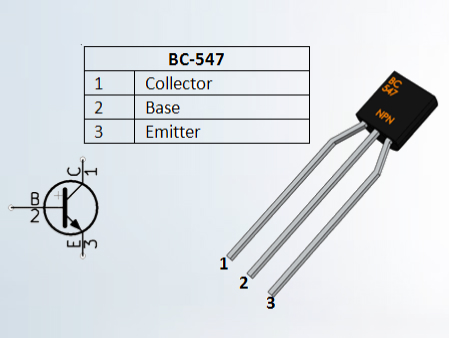The BC547 is a popular NPN transistor used in many electronic projects. It is known for its ability to amplify signals and act as a switch. This guide will help you understand the pin configuration of the BC547 transistor, its pinout, and how it works in circuits.
What Is A BC547 Transistor?
The BC547 is an NPN bipolar junction transistor (BJT). It is commonly used for small signal amplification and switching in various circuits. It can amplify weak signals and turn things on and off in circuits. The BC547 can handle a maximum current of 100mA and a voltage of 45V, making it suitable for many general-purpose applications.
BC547 Pin Configuration
The BC547 transistor has three pins, and each pin has a specific function. These are:
- Collector (C) – Pin 1
- Base (B) – Pin 2
- Emitter (E) – Pin 3
Each of these pins plays a role in how the transistor works.
BC547 Pinout
Collector (C) – Pin 1: The collector pin is where current flows through the transistor. In a circuit, a load (such as a motor or LED) is connected to the collector, and when the transistor is turned on, current flows through this pin.
Base (B) – Pin 2: The base pin controls the transistor. A small current is applied to the base, which allows a much larger current to flow between the collector and emitter. It is like an “on/off” switch for a transistor.
Emitter (E) – Pin 3: The emitter is the output of the transistor. It is usually connected to ground (or negative), and current flows through the emitter when the transistor is on.
How Does The BC547 Work?
The BC547 works as an amplifier or switch:
Amplifier: When used as an amplifier, a small current at the base controls a larger current flowing from the collector to the emitter. The transistor amplifies the signal to make it stronger.
Switch: When used as a switch, a transistor allows current to flow from the collector to the emitter when a small current is applied to the base. If no current is applied to the base, the transistor remains off, and no current flows.
BC547 Pin Configuration in Circuit
Common Emitter Configuration: In this setup, the emitter is usually connected to the ground. A small current at the base allows current to flow between the collector and emitter. This is the most common way to use the BC547, especially in amplifiers.
Common Base Configuration: In this setup, the base is the input, and the output is taken from the collector. This is less common but is used in some special cases.
Common Collector Configuration: This is used for voltage buffering. The base is driven by a signal, and the output comes from the emitter. This configuration is useful for matching the impedance of the circuit.
BC547 Transistor Characteristics
Maximum Voltage: The BC547 can handle a maximum collector-emitter voltage of 45V. It should not be used with voltages higher than this.
Maximum Current: The transistor can handle up to 100mA of current. Be careful not to exceed this, or the transistor may be damaged.
Gain (hFE): Transistors have a gain factor, typically between 200-800. This means that a small current at the base can handle a very large current between the collector and emitter.
Power Dissipation: The BC547 can safely dissipate up to 500mW of power. If this limit is exceeded, the transistor may overheat.
Common Uses of the BC547 Transistor
Amplifier: The BC547 is often used in small audio amplifiers or to amplify weak electrical signals.
Switching: It can act as a switch to turn things on or off, such as controlling LEDs, motors, or relays.
Oscillator: When combined with other components, the BC547 can create an oscillator to produce signals such as square waves.
Current Regulation: Transistors can help regulate or limit the current in a circuit.
Explore BC547 Transistors on Magnificette
At Magnificette, we offer reliable transistors for your electronics projects. Our BC547 NPN and CTBC547B NPN transistors are suitable for general use, providing stable performance in both amplification and switching circuits. Whether you are building a DIY project or working on a professional design, our transistors offer durability and quality.
Conclusion
The BC547 is a small but powerful transistor with a simple pin arrangement: collector, base, and emitter. It can be used for amplification or switching in many electronics projects. Whether you are building an audio amplifier, switching device, or signal processing circuit, the BC547 is a great choice due to its ease of use, reliability, and versatility in a variety of applications.
Read Next: Lithium-ion vs. Lithium Polymer: Key Differences and Which Is Better








Leave a Reply